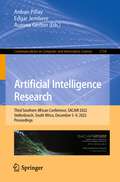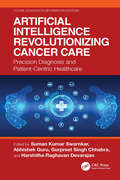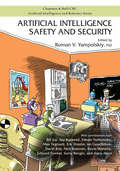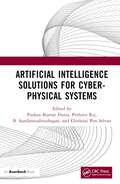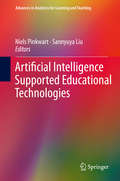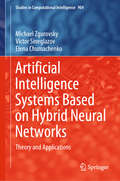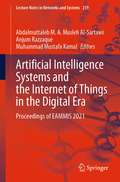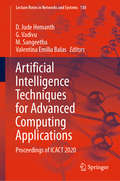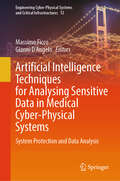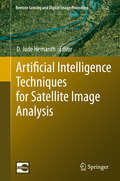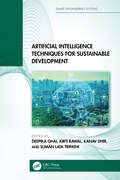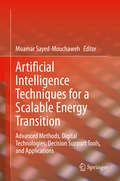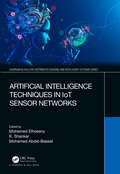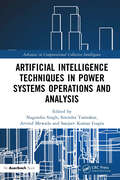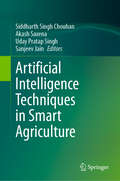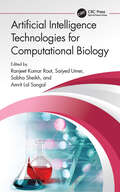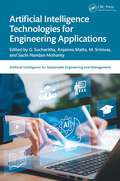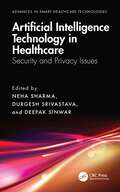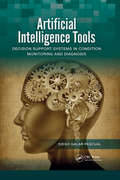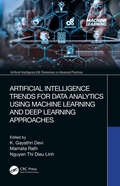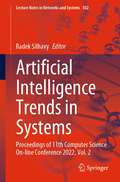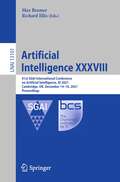- Table View
- List View
Artificial Intelligence Research: Third Southern African Conference, SACAIR 2022, Stellenbosch, South Africa, December 5–9, 2022, Proceedings (Communications in Computer and Information Science #1734)
by Aurona Gerber Edgar Jembere Anban PillayThis book constitutes the refereed proceedings of the Third Southern African Conference on Artificial Intelligence Research, SACAIR 2022, held in Stellenbosch, South Africa, in December 2022. The 26 papers presented were thoroughly reviewed and selected from the 73 submissions. They are organized on the topical sections on algorithmic, data driven and symbolic AI; socio-technical and human-centered AI; responsible and ethical AI.
Artificial Intelligence Revolution: How AI Will Change our Society, Economy, and Culture
by Robin LiThe co-founder of Baidu explains how AI will transform human livelihood, from our economy and financial systems down to our daily lives. Written by Baidu cofounder Robin Li and prefaced by award-winning sci-fi writer Cixin Liu (author of The Three-Body Problem), Artificial Intelligence Revolution introduces Baidu&’s teams of top scientists and management as pioneers of movement toward AI. The book covers many of the latest AI-related ideas and technological developments, such as: Computational abilityBig data resourcesSetting the basic standards of AI in research and developmentAn introduction to the &“super brain&”Intelligent manufacturingDeep learningL4 automated vehiclesSmart finance The book describes the emergence of a &“smart&” society powered by technology and reflects on the challenges humanity is about to face. Li covers the most pressing AI-related ideas and technological developments, including: Will artificial intelligence replace human workers, and in what sectors of the economy? How will it affect healthcare and finance? How will daily human life change? Robin Li&’s Artificial Intelligence Revolution addresses these questions and more from the perspective of a pioneer of AI development. It's a must-read for anyone concerned about the emergence of a &“smart&” society powered by technology and the challenges humanity is about to face.
Artificial Intelligence Revolutionizing Cancer Care: Precision Diagnosis and Patient-Centric Healthcare (Future Generation Information Systems)
by Suman Kumar Swarnkar Gurpreet Singh Chhabra Abhishek Guru Harshitha Raghavan DevarajanIn the ever-evolving landscape of cancer treatment, the fusion of artificial intelligence (AI) with medical science marks a groundbreaking shift toward more precise, efficient, and personalized healthcare. Artificial Intelligence Revolutionizing Cancer Care: Precision Diagnosis and Patient-Centric Healthcare delves into the transformative power of AI, offering a comprehensive exploration of its role in enhancing cancer diagnosis, treatment, and patient management. This edited volume brings together leading experts and researchers who illuminate the latest advancements in AI technologies applied to oncology. From machine learning algorithms that predict cancer progression to sophisticated imaging techniques that improve diagnostic accuracy, this book covers a spectrum of innovations reshaping cancer care. Key highlights include precision diagnosis, uncovering how AI-driven tools are revolutionizing the early detection and accurate classification of various cancer types, leading to better patient outcomes; patient-centric approaches, exploring the shift toward personalized medicine, where AI tailors treatment protocols to individual patient profiles, ensuring more effective and targeted therapies; and ethical and practical considerations, gaining insights into the ethical, practical, and regulatory challenges of integrating AI in healthcare, emphasizing the need for patient privacy and data security. Additionally, the book looks ahead to the potential future applications of AI in oncology, including predictive analytics, robotic surgery, and beyond. Artificial Intelligence Revolutionizing Cancer Care is an essential resource for medical professionals, researchers, and students seeking to understand the intersection of AI and oncology. It offers a visionary perspective on how cutting-edge technology is poised to enhance patient care and transform the fight against cancer.This book focuses on the critical intersection of artificial intelligence and cancer diagnosis within the healthcare sector emphasizes the real-world impact of artificial intelligence in improving cancer detection, treatment, and overall patient care covers artificial intelligence algorithms, machine learning techniques, medical image analysis, predictive modeling, and patient care applications explores how artificial intelligence technologies enhance the patient’s experience, resulting in better outcomes and reduced healthcare disparities provides readers with an understanding of the mathematics underpinning machine learning models, including decision trees, support vector machines, and deep neural networks It is primarily written for senior undergraduates, graduate students, and academic researchers in the fields of electrical engineering, electronics and communications engineering, computer science and engineering, biomedical engineering, and information technology.
Artificial Intelligence Safety and Security (Chapman & Hall/CRC Artificial Intelligence and Robotics Series)
by Roman V. YampolskiyThe history of robotics and artificial intelligence in many ways is also the history of humanity’s attempts to control such technologies. From the Golem of Prague to the military robots of modernity, the debate continues as to what degree of independence such entities should have and how to make sure that they do not turn on us, its inventors. Numerous recent advancements in all aspects of research, development and deployment of intelligent systems are well publicized but safety and security issues related to AI are rarely addressed. This book is proposed to mitigate this fundamental problem. It is comprised of chapters from leading AI Safety researchers addressing different aspects of the AI control problem as it relates to the development of safe and secure artificial intelligence. The book is the first edited volume dedicated to addressing challenges of constructing safe and secure advanced machine intelligence. The chapters vary in length and technical content from broad interest opinion essays to highly formalized algorithmic approaches to specific problems. All chapters are self-contained and could be read in any order or skipped without a loss of comprehension.
Artificial Intelligence Solutions for Cyber-Physical Systems
by Pethuru Raj Chithirai Pon Selvan B. Sundaravadivazhagan Pushan Kumar DuttaSmart manufacturing environments are revolutionizing the industrial sector by integrating advanced technologies, such as the Internet of Things (IoT), artificial intelligence (AI), and robotics, to achieve higher levels of efficiency, productivity, and safety. However, the increasing complexity and interconnectedness of these systems also introduce new security challenges that must be addressed to ensure the safety of human workers and the integrity of manufacturing processes. Key topics include risk assessment methodologies, secure communication protocols, and the development of standard specifications to guide the design and implementation of HCPS. Recent research highlights the importance of adopting a multi-layered approach to security, encompassing physical, network, and application layers. Furthermore, the integration of AI and machine learning techniques enables real-time monitoring and analysis of system vulnerabilities, as well as the development of adaptive security measures.Artificial Intelligence Solutions for Cyber-Physical Systems discusses such best practices and frameworks as NIST Cybersecurity Framework, ISO/IEC 27001, and IEC 62443 of advanced technologies. It presents strategies and methods to mitigate risks and enhance security, including cybersecurity frameworks, secure communication protocols, and access control measures. The book also focuses on the design, implementation, and management of secure HCPS in smart manufacturing environments. It covers a wide range of topics, including risk assessment, security architecture, data privacy, and standard specifications, for HCPS. The book highlights the importance of securing communication protocols, the role of artificial intelligence and machine learning in threat detection and mitigation, and the need for robust cybersecurity frameworks in the context of smart manufacturing.
Artificial Intelligence Supported Educational Technologies (Advances in Analytics for Learning and Teaching)
by Niels Pinkwart Sannyuya LiuThis book includes a collection of expanded papers from the 2019 Sino-German Symposium on AI-supported educational technologies, which was held in Wuhan, China, March, 2019. The contributors are distinguished researchers from computer science and learning science. The contributions are organized in four sections: (1) Overviews and systematic perspectives , (2) Example Systems, (3) Algorithms, and (4) Insights gained from empirical studies. For example, different data mining and machine learning methods to quantify different profiles of a learner in different learning situations (including interaction patterns, cognitive modes, knowledge skills, interests and emotions etc.) as well as connections to measurements in psychology and learning sciences are discussed in the chapters.
Artificial Intelligence Systems Based on Hybrid Neural Networks: Theory and Applications (Studies in Computational Intelligence #904)
by Michael Zgurovsky Victor Sineglazov Elena ChumachenkoThis book is intended for specialists as well as students and graduate students in the field of artificial intelligence, robotics and information technology. It is will also appeal to a wide range of readers interested in expanding the functionality of artificial intelligence systems. One of the pressing problems of modern artificial intelligence systems is the development of integrated hybrid systems based on deep learning. Unfortunately, there is currently no universal methodology for developing topologies of hybrid neural networks (HNN) using deep learning. The development of such systems calls for the expansion of the use of neural networks (NS) for solving recognition, classification and optimization problems. As such, it is necessary to create a unified methodology for constructing HNN with a selection of models of artificial neurons that make up HNN, gradually increasing the complexity of their structure using hybrid learning algorithms.
Artificial Intelligence Systems and the Internet of Things in the Digital Era: Proceedings of EAMMIS 2021 (Lecture Notes in Networks and Systems #239)
by Muhammad Mustafa Kamal Anjum Razzaque Abdalmuttaleb M. A. Musleh Al-SartawiThis book brings together intelligence systems and the Internet of Things, with special attention given to the opportunities, challenges, for education, business growth, and economic progression of nations which will help societies (economists, financial managers, engineers, ICT specialists, digital managers, data managers, policymakers, regulators, researchers, academics, and students) to better understand, use, and control AI and IoT to develop future strategies and to achieve sustainability goals. EAMMIS 2021 was organized by the Bridges Foundation in cooperation with the Istanbul Medeniyet University, Istanbul, Turkey, on March 19–20, 2021. EAMMIS 2021 theme was Artificial Intelligence Systems and the Internet of Things in the digital era. The papers presented at the conference provide a holistic view of AI education, MIS, cybersecurity, blockchain, Internet of Ideas (IoI), and knowledge management.
Artificial Intelligence Systems in Environmental Engineering
by Azeem Irshad Jamal Mabrouki Azrour MaroudeSpecialists are paying attention to the growing concern for environmental issues. Artificial Intelligence Systems in Environmental Engineering uses techniques from the field of Artificial Intelligence as the alternative to address problems that are difficult to model by analytical methods. The book provides a general study and introduces a set of techniques for environmental engineering. With a particular focus on climate change and energy policy, it discusses innovative solutions and models that can positively influence and increase the efficiency of resource use and decrease the impact on the environment while developing the well-being of individuals. The book will be of most interest to research students who have a scientific approach and deal with problems related to environmental engineering.
Artificial Intelligence Techniques for Advanced Computing Applications: Proceedings of ICACT 2020 (Lecture Notes in Networks and Systems #130)
by Valentina Emilia Balas D. Jude Hemanth G. Vadivu M. SangeethaThis book features a collection of high-quality research papers presented at the International Conference on Advanced Computing Technology (ICACT 2020), held at the SRM Institute of Science and Technology, Chennai, India, on 23–24 January 2020. It covers the areas of computational intelligence, artificial intelligence, machine learning, deep learning, big data, and applications of artificial intelligence in networking, IoT and bioinformatics
Artificial Intelligence Techniques for Analysing Sensitive Data in Medical Cyber-Physical Systems: System Protection and Data Analysis (Engineering Cyber-Physical Systems and Critical Infrastructures #12)
by Massimo Ficco Gianni D’AngeloThis book presents the major advances in techniques to preserve privacy and security requirements connected with the use of AI and machine learning (ML) to analyse and manage sensitive data in MCPSs. The advances in Internet of things and artificial intelligence (AI) have witnessed great progress on healthcare technologies in several application domains. In particular, the interconnection between the physical spaces, characterized by physical devices able to collect users’ health information, with the cyberspace, also known as the virtual space, has fostered the development of intelligent Medical Cyber-Physical Systems (MCPSs) with the capability to deliver real-time healthcare services. On the other hand, the potential innovation that these technologies bring to improve patient care, by remotely analysing health parameters using medical devices, advanced smart sensors, and AI, is hampered by security and privacy challenges related to the managed sensitive data. Starting from the state of the art on AI and ML for medical applications and digital health, an accurate analysis of privacy and security risks associated with the use of the MCPSs is presented. Then, Digital Twins are introduced as a significant technique to enhance decision-making through learning and reasoning of collected on-field real-time data. Moreover, decentralized healthcare data management approaches based on federated learning, tiny machine learning, and blockchain technologies have been introduced to shift control and responsibility of healthcare data management from individual centralized entities to a more distributed structure, preserving privacy and security. Finally, the application of AI-based security monitoring approaches in healthcare is discussed. In this book, both theoretical and practical approaches are used to allow readers to understand complex topics and concepts easily also through real-life scenarios.
Artificial Intelligence Techniques for Satellite Image Analysis (Remote Sensing and Digital Image Processing #24)
by D. Jude HemanthThe main objective of this book is to provide a common platform for diverse concepts in satellite image processing. In particular it presents the state-of-the-art in Artificial Intelligence (AI) methodologies and shares findings that can be translated into real-time applications to benefit humankind. Interdisciplinary in its scope, the book will be of interest to both newcomers and experienced scientists working in the fields of satellite image processing, geo-engineering, remote sensing and Artificial Intelligence. It can be also used as a supplementary textbook for graduate students in various engineering branches related to image processing.
Artificial Intelligence Techniques for Sustainable Development (Smart Engineering Systems: Design and Applications)
by Suman Lata Tripathi Kanav Dhir Deepika Ghai Kirti RawalHow can the efficiency of the algorithms be increased with a lesser number of computations as well as optimized with the resources for cost-effective solutions? Artificial Intelligence Techniques for Sustainable Development provides an answer. Further, it discusses important concepts such as green communication network design and implementation for the Internet of Things ecosystem, green computing in network security, and artificial intelligence models for remote sensing applications.Key features: Presents the latest tools and techniques in developing solutions intended for resource utilization, energy efficiency, and human and environmental health Highlights the advancement in electronics and communication technology for green applications Covers smart energy harvesting/charging and power management techniques using machine learning Explains green communication network design and implementation for the Internet of Things ecosystem, and green computing in network security Illustrates prediction models for carbon emission and sequestration, environmental health, and climate change The book is aimed at senior undergraduates, graduate students, and academic researchers in the fields of electrical engineering, electronics, and communications engineering, computer science and engineering, environmental engineering, and biomedical engineering.
Artificial Intelligence Techniques for a Scalable Energy Transition: Advanced Methods, Digital Technologies, Decision Support Tools, and Applications
by Moamar Sayed-MouchawehThis book presents research in artificial techniques using intelligence for energy transition, outlining several applications including production systems, energy production, energy distribution, energy management, renewable energy production, cyber security, industry 4.0 and internet of things etc. The book goes beyond standard application by placing a specific focus on the use of AI techniques to address the challenges related to the different applications and topics of energy transition. The contributions are classified according to the market and actor interactions (service providers, manufacturers, customers, integrators, utilities etc.), to the SG architecture model (physical layer, infrastructure layer, and business layer), to the digital twin of SG (business model, operational model, fault/transient model, and asset model), and to the application domain (demand side management, load monitoring, micro grids, energy consulting (residents, utilities), energy saving, dynamic pricing revenue management and smart meters, etc.).
Artificial Intelligence Techniques in IoT Sensor Networks (Chapman & Hall/CRC Distributed Sensing and Intelligent Systems Series)
by Mohamed Elhoseny K. Shankar Mohamed Abdel-BassetArtificial Intelligence Techniques in IoT Sensor Networks is a technical book which can be read by researchers, academicians, students and professionals interested in artificial intelligence (AI), sensor networks and Internet of Things (IoT). This book is intended to develop a shared understanding of applications of AI techniques in the present and near term. The book maps the technical impacts of AI technologies, applications and their implications on the design of solutions for sensor networks. This text introduces researchers and aspiring academicians to the latest developments and trends in AI applications for sensor networks in a clear and well-organized manner. It is mainly useful for research scholars in sensor networks and AI techniques. In addition, professionals and practitioners working on the design of real-time applications for sensor networks may benefit directly from this book. Moreover, graduate and master’s students of any departments related to AI, IoT and sensor networks can find this book fascinating for developing expert systems or real-time applications. This book is written in a simple and easy language, discussing the fundamentals, which relieves the requirement of having early backgrounds in the field. From this expectation and experience, many libraries will be interested in owning copies of this work.
Artificial Intelligence Techniques in Power Systems Operations and Analysis (Advances in Computational Collective Intelligence)
by Sanjeev Kumar Gupta Sitendra Tamrakar Nagendra Singh Arvind MewadaAn electrical power system consists of a large number of generation, transmission, and distribution subsystems. It is a very large and complex system; hence, its installation and management are very difficult tasks. An electrical system is essentially a very large network with very large data sets. Handling these data sets can require much time to analyze and subsequently implement. An electrical system is necessary but also potentially very dangerous if not operated and controlled properly. The demand for electricity is ever increasing, so maintaining load demand without overloading the system poses challenges and difficulties. Thus, planning, installing, operating, and controlling such a large system requires new technology. Artificial intelligence (AI) applications have many key features that can support a power system and handle overall power system operations. AI-based applications can manage the large data sets related to a power system. They can also help design power plants, model installation layouts, optimize load dispatch, and quickly respond to control apparatus. These applications and their techniques have been successful in many areas of power system engineering. Artificial Intelligence Techniques in Power Systems Operations and Analysis focuses on the various challenges arising in power systems and how AI techniques help to overcome these challenges. It examines important areas of power system analysis and the implementation of AI-driven analysis techniques. The book helps academicians and researchers understand how AI can be used for more efficient operation. Multiple AI techniques and their application are explained. Also featured are relevant data sets and case studies. Highlights include: Power quality enhancement by PV-UPQC for non-linear load Energy management of a nanogrid through flair of deep learning from IoT environments Role of artificial intelligence and machine learning in power systems with fault detection and diagnosis AC power optimization techniques Artificial intelligence and machine learning techniques in power systems automation
Artificial Intelligence Techniques in Smart Agriculture
by Sanjeev Jain Siddharth Singh Chouhan Uday Pratap Singh Akash SaxenaThis edited volume explores the integration of artificial intelligence to improve crop production. It addresses the critical need for intelligent crop management in light of the world's escalating population. Encompassing a spectrum of technologies, including computer vision, image processing, soft computing, machine learning, and deep learning, the book explores advancements in decision-making systems. It integrates data science methodologies, Internet of Things, wireless communications, and a range of sensors and actuators to provide precise, timely, and cost-effective solutions to agricultural challenges, ultimately enhancing both the quality and quantity of crop yields. The book empowers its audience to direct their efforts towards designing models and prototypes that benefit society and the environment, making it an indispensable resource for those eager to shape the future of intelligent agriculture. It serves as a comprehensive guide for students, scholars, and academicians keen on delving into the transformative field of artificial intelligence in agriculture. Researchers, scientists, and field experts will find invaluable insights to guide their exploration and contribution to this domain.
Artificial Intelligence Technologies for Computational Biology
by Ranjeet Kumar Rout Saiyed Umer Sabha Sheikh Amrit Lal SangalThis text emphasizes the importance of artificial intelligence techniques in the field of biological computation. It also discusses fundamental principles that can be applied beyond bio-inspired computing.It comprehensively covers important topics including data integration, data mining, machine learning, genetic algorithms, evolutionary computation, evolved neural networks, nature-inspired algorithms, and protein structure alignment. The text covers the application of evolutionary computations for fractal visualization of sequence data, artificial intelligence, and automatic image interpretation in modern biological systems.The text is primarily written for graduate students and academic researchers in areas of electrical engineering, electronics engineering, computer engineering, and computational biology.This book:• Covers algorithms in the fields of artificial intelligence, and machine learning useful in biological data analysis.• Discusses comprehensively artificial intelligence and automatic image interpretation in modern biological systems.• Presents the application of evolutionary computations for fractal visualization of sequence data.• Explores the use of genetic algorithms for pair-wise and multiple sequence alignments.• Examines the roles of efficient computational techniques in biology.
Artificial Intelligence Technologies for Engineering Applications (Artificial Intelligence for Sustainable Engineering and Management)
by Sachi Nandan Mohanty G. Sucharitha Anjanna Matta M. SrinivasThis book enables the readers to design, optimize, and control complex systems with greater precision and efficiency. It further provides practical insights and presents case studies for readers interested in exploring the intersections between artificial intelligence and industry. This book discusses important topics such as algorithmic design, mathematical modeling, natural language processing, machine learning, and computer vision.This book: Explores practical applications of artificial intelligence in engineering, including optimization, predictive modeling, decision‑making, and control systems Provides real‑world examples of the applications of artificial intelligence in engineering, drawing from a range of industries, including aerospace, automotive, and manufacturing Discusses technologies such as machine learning and computer vision for aircraft design optimization, fault diagnosis, and autonomous navigation Explains natural language processing for analyzing and optimizing building systems, while robotics can be used for construction automation Presents artificial intelligence technologies for optimization of manufacturing processes, predictive maintenance, and quality control This book is primarily written for senior undergraduates, graduate students, and academic researchers in the fields of electrical engineering, electronics and communications engineering, computer science and engineering, and information technology.
Artificial Intelligence Technology in Healthcare: Security and Privacy Issues (Advances in Smart Healthcare Technologies)
by Neha Sharma Deepak Sinwar Durgesh SrivastavaArtificial Intelligence Technology in Healthcare: Security and Privacy Issues focuses on current issues with patients’ privacy and data security including data breaches in healthcare organizations, unauthorized access to patients’ information, and medical identity theft. It explains recent breakthroughs and problems in deep learning security and privacy issues, emphasizing current state-of-the-art methods, methodologies, implementation, attacks, and countermeasures. It examines the issues related to developing artifiicial intelligence (AI)-based security mechanisms which can gather or share data across several healthcare applications securely and privately. Features: Combines multiple technologies (i.e., Internet of Things [IoT], Federated Computing, and AI) for managing and securing smart healthcare systems. Includes state-of-the-art machine learning, deep learning techniques for predictive analysis, and fog and edge computing-based real-time health monitoring. Covers how to diagnose critical diseases from medical imaging using advanced deep learning-based approaches. Focuses on latest research on privacy, security, and threat detection on COVID-19 through IoT. Illustrates initiatives for research in smart computing for advanced healthcare management systems. This book is aimed at researchers and graduate students in bioengineering, artificial intelligence, and computer engineering.
Artificial Intelligence Tools: Decision Support Systems in Condition Monitoring and DIagnosis
by Diego Galar PascualArtificial Intelligence Tools: Decision Support Systems in Condition Monitoring and Diagnosis discusses various white- and black-box approaches to fault diagnosis in condition monitoring (CM). This indispensable resource:Addresses nearest-neighbor-based, clustering-based, statistical, and information theory-based techniquesConsiders the merits of e
Artificial Intelligence Trends for Data Analytics Using Machine Learning and Deep Learning Approaches (Artificial Intelligence (AI): Elementary to Advanced Practices)
by K. Gayathri Devi Mamata Rath Nguyen Thi Dieu LinhArtificial Intelligence (AI), when incorporated with machine learning and deep learning algorithms, has a wide variety of applications today. This book focuses on the implementation of various elementary and advanced approaches in AI that can be used in various domains to solve real-time decision-making problems. The book focuses on concepts and techniques used to run tasks in an automated manner. It discusses computational intelligence in the detection and diagnosis of clinical and biomedical images, covers the automation of a system through machine learning and deep learning approaches, presents data analytics and mining for decision-support applications, and includes case-based reasoning, natural language processing, computer vision, and AI approaches in real-time applications. Academic scientists, researchers, and students in the various domains of computer science engineering, electronics and communication engineering, and information technology, as well as industrial engineers, biomedical engineers, and management, will find this book useful. By the end of this book, you will understand the fundamentals of AI. Various case studies will develop your adaptive thinking to solve real-time AI problems. Features Includes AI-based decision-making approaches Discusses computational intelligence in the detection and diagnosis of clinical and biomedical images Covers automation of systems through machine learning and deep learning approaches and its implications to the real world Presents data analytics and mining for decision-support applications Offers case-based reasoning
Artificial Intelligence Trends in Systems: Proceedings of 11th Computer Science On-line Conference 2022, Vol. 2 (Lecture Notes in Networks and Systems #502)
by Radek SilhavyThis book covers themes related to artificial intelligence in systems and networks application. Selected papers explore modern neural networks application, optimization and hybrid and bio-inspired algorithms are covered too. The refereed proceedings of the Artificial Intelligence Trends in Systems part of the 11th Computer Science On-line Conference 2022 (CSOC 2022), conducted online in April 2022, are included in this volume.
Artificial Intelligence Using Federated Learning: Fundamentals, Challenges, and Applications (Intelligent Manufacturing and Industrial Engineering)
by Diego Oliva Valentina E. Balas Ahmed A. ElngarFederated machine learning is a novel approach to combining distributed machine learning, cryptography, security, and incentive mechanism design. It allows organizations to keep sensitive and private data on users or customers decentralized and secure, helping them comply with stringent data protection regulations like GDPR and CCPA.Artificial Intelligence Using Federated Learning: Fundamentals, Challenges, and Applications enables training AI models on a large number of decentralized devices or servers, making it a scalable and efficient solution. It also allows organizations to create more versatile AI models by training them on data from diverse sources or domains. This approach can unlock innovative use cases in fields like healthcare, finance, and IoT, where data privacy is paramount.The book is designed for researchers working in Intelligent Federated Learning and its related applications, as well as technology development, and is also of interest to academicians, data scientists, industrial professionals, researchers, and students.
Artificial Intelligence XXXVIII: 41st SGAI International Conference on Artificial Intelligence, AI 2021, Cambridge, UK, December 14–16, 2021, Proceedings (Lecture Notes in Computer Science #13101)
by Richard Ellis Max BramerThis book constitutes the proceedings of the 41st SGAI International Conference on Innovative Techniques and Applications of Artificial Intelligence, AI 2021, which was supposed to be held in Cambridge, UK, in December 2021. The conference was held virtually due to the COVID-19 pandemic.The 22 full papers and 10 short papers presented in this volume were carefully reviewed and selected from 37 submissions. The volume includes technical papers presenting new and innovative developments in the field as well as application papers presenting innovative applications of AI techniques in a number of subject domains. The papers are organized in the following topical sections: technical paper; machine learning; AI techniques; short technical stream papers; application papers; applications of machine learning; AI for medicine; advances in applied AI; and short application stream papers.
